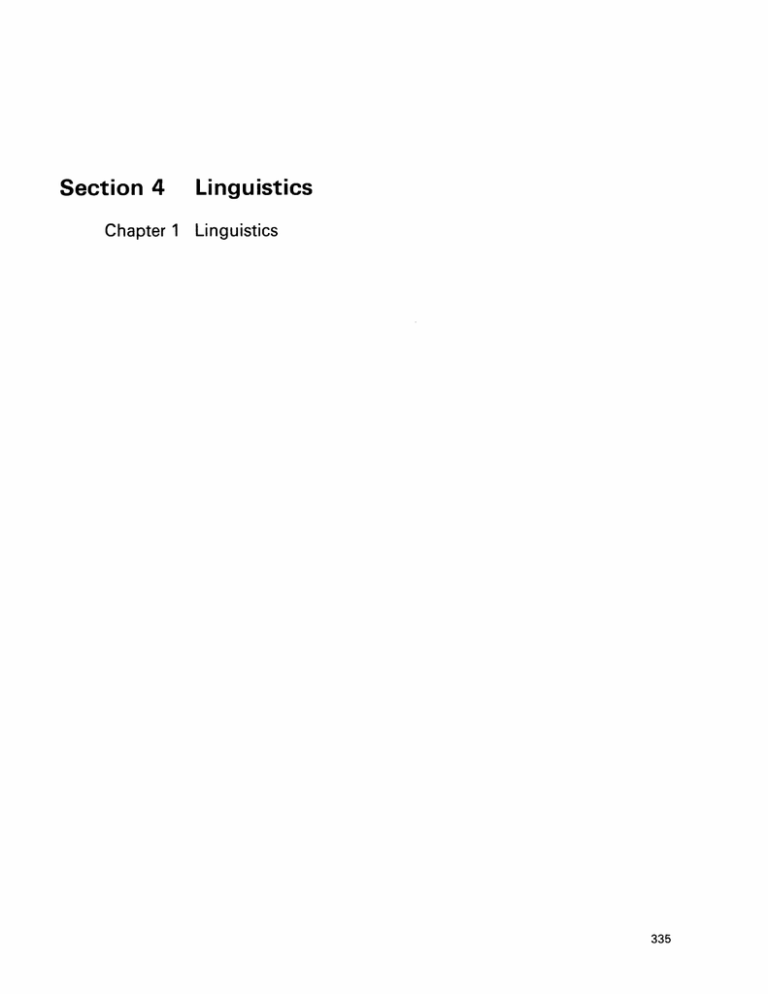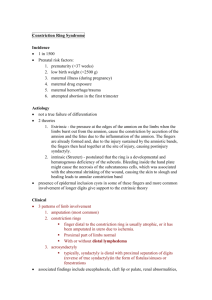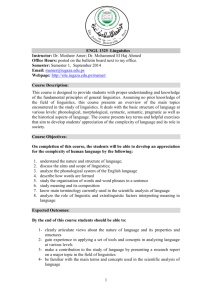Linguistics Section 4 Chapter 1 Linguistics 335
advertisement

Section 4 Linguistics Chapter 1 Linguistics 335 336 RLE Progress Report Number 132 Chapter 1. Linguistics Chapter 1. Linguistics Academic and Research Staff Professor Morris Halle, Professor Noam A. Chomsky 1.1 Introduction The work of the Linguistics group is directed towards obtaining a better grasp of the mental capacities of human beings through the study of the nature, acquisition and use of language. Language is a uniquely human faculty in that only humans appear to be capable of learning and using a language and that every normal human acquires knowledge of one or more languages during his/her lifeThis knowledge is represented time. somehow in the speaker's mind, which is a special organ located in the human brain. Viewed from this vantage point, the central issues of linguistics research are: 1. What is the nature of this knowledge? What do speakers of a particular language - Lattvian, Spanish or Walpiri - know, and how does knowledge of one language differ from and resemble that of some other language? 2. How do speakers acquire this knowledge? 3. How do speakers put this knowledge to use in producing and understanding utterances? 4. What are the physiological mechanisms that provide the material basis for the storage, acquisition and utilization of linguistic knowledge? There are considerable differences in our ability to answer these questions. It would seem that at present we have advanced more with regard to question 1 and least with These differences are also question 4. reflected in the research conducted by the group. At this time, it is most heavily concentrated on issues concerned with the nature of the knowledge that characterizes fluent speakers of various languages. Yet the other three questions have not been over- looked, and significant efforts are being devoted to their solution. The study of these topics is being carried out along a number of parallel lines. On the one hand, linguists have investigated the principles by which words are concatenated to form meaningful sentences. These principles have been the primary domain of inquiry of the disciplines of syntax and semantics. Phonology studies the sound structure of words while morphology examines the manner in which different languages combine different meaning-bearing units (specifically, stems, prefixes, suffixes and infixes) to form words. The latter topic has attracted increasing interest in recent years and is likely to become more prominent in the future. 1.2 Abstracts of Doctoral Dissertations All of the following are abstracts of dissertations submitted to the Department of Linguistics and Philosophy in partial fulfillment of the requirements for the degree of Doctor of Philosophy in Linguistics. 1.2.1 Phonology of Articulation Alicja Gorecka Abstract In this thesis, I focus on the phonological representation of the articulatory component of speech production. I argue for a phonological constituent called the Constriction Node, which represents the constriction Within the segmental tree (cf. gesture. Sagey (1986)), the Con(1985), Clements 337 Chapter 1. Linguistics struction Node is a daughter of the Root Node (in the sense of the Clements/Sagey model). It itself dominates the Site, which corresponds to the constriction location, and the Articulator, which corresponds to the organ executing the constriction gesture. The model of segment representation which includes the Constriction Node is represented as follows: Root Node Lmurngeeal Featuree anner Features (Cntriction) Sits Constriction Articulator In this model, the Site ranges over the features Labial, Anterior, Palatal, Velar, and Pharyngeal. The Articulator can have either of the values: Lower Lip, Tongue Blade, Tongue Body, Tongue Root. The constriction model reconciles two traditions of segment characterization: the IPA tradition, which stresses the importance of the constriction location features, and the SPE (Chomsky and Halle (1968)) tradition of giving priority to the features based on the active articulator. It adopts the hierarchical view of segment representation introduced by Clements (1985) and Sagey (1986). In particular, it adopts the concept of an Articulator as it is developed in Sagey (1986). The constriction model offers a view of segment representation closely modelled on the physical reality which it represents: the constriction gesture is a necessary element of speech production. On the phonological side, the main advantage of the constriction model is that it makes all articulation features equally available to consonants and vowels; this is what allows it to account for vowel/consonant interaction phenomena (e.g., mutual vowel/consonant palatalization, velarization, and pharyngealization, among others). Also, by offering more structured representations, 338 RLE Progress Report Number 132 this model goes even further than the previous models in the direction of limiting the number of phonological processes which do not occur. This thesis is organized as follows: Chapter 1 introduces the constriction model. Chapters 2 and 3 argue for the phonological constituent Articulator, and the phonological constituent Site (respectively) on the basis of the examples which can be analyzed only in terms of these features. Chapter 4 deals with the structure within the Constriction Node. In chapter 5, the articulatory basis of Site and Articulator features, and the phonological motivation for treating vowels in terms of such features are discussed. Chapter 6 discusses some residual questions in the representation of consonants. Finally, chapter 7 considers the consequences that follow from applying the constriction model in the analysis of various phonological processes. 1.2.2 A Case Study in the Syntax of Agreement: Hebrew Noun Phrases and Benoni Verb Phrases Elizabeth Ann Ritter Abstract This dissertation investigates the role of number and gender agreement in two Hebrew contexts; present tense sentences and genitive noun phrases. As a point of departure, I adopt a recent proposal by Pollock (1987) that agreement projects a distinct syntactic category from tense. Thus, the analysis of S as IP, the maximal projection of inflection (I), is replaced by an analysis of S as TP, the maximal projection of tense (T). The complement of T on this view is AGRP, the maximal projection of agreement (AGR). In the spirit of this proposal, I assume that noun phrases are maximal projections of a functional category, determiner (D), and that the complement of D is a second functional category, which I call P. Although the position of P within the noun phrase parallels that of AGRP in the sentence, and AGR have distinct functions. In chapter 2, I investigate the properties of present tense sentences in Hebrew. These Chapter 1. Linguistics sentences contain benoni verb, which are distinguished from their past and future counterparts in that they are inflected for the number and gender, but not the person, of their subjects. The syntax of present tense sentences in Hebrew sheds light on the role of agreement in the assignment of nominative case and in the licensing of null subjects. I show that only an analysis which separates tense and agreement can account for the full range of construction in the present tense. In chapter 3, I study the range of noun phrases containing postnominal genitives. These structures provide crucial evidence for the separate projection of a functional category, which I call #, and D. The head manifests grammatical number (and possible A gender) of its nominal complement. striking feature of derived nominals in Hebrew is that the subject always appears between the head noun and object. In order to account for the surface order of the constituents within these noun phrases, I posit functional projections which provide landing sites for movement of the head noun, analogous to verb movement in sentences. A comparison of different genitive constructions motivates the two distinct functional categories postulated. 1.2.3 Metrical Dependencies in Tone Assignment Brian Mark Sietsema Abstract This thesis presents metrical analyses of tone assignment (tone shift, tone insertion, tone spread) in four Bantu languages of Tanzania. A constrained metrical system of rules and parameter (Halle and Vergnaud 1987) is introduced and applied to these languages in order to explain a variety of long-distance The metrical analysis tone phenomena. reduces these phenomena to a set of local operations within an autosegmental theory of phonology. Along with the introduction to metrical theory (chapter 1), a theory of tone and morphology for the Bantu language as is sketched out and illustrated by partial analysis of Kimatuumbi and Ci-Ruri (chapter 2). Fuller analyses of Digo (chapter 3) and Sukuma (chapter 4) follow, building on the theoretical devices which were developed for the analyses of Kimatuumbi and Ci-Ruri. Metrical structure is shown to play a profound role in the tonology of these languages. The study concludes by drawing out the theoretical implications of the previous analyses, with particular attention to the typology of tone-accent interactions. 339 340 RLE Progress Report Number 132






